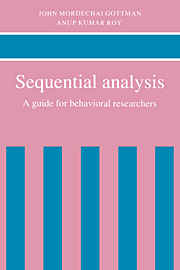Book contents
- Frontmatter
- Contents
- Preface
- Reading this book quickly
- Part I Introduction
- Part II Fitting the timetable
- Part III The timetable and the contextual design
- Chapter 10 Log-linear models
- Chapter 11 Log-linear models: review and examples
- Chapter 12 A single case analysis of the timetable
- Chapter 13 Logit models and logistic regression
- Chapter 14 The problem of autocontingency and its solutions
- Chapter 15 Recent advances: a brief overview
- Chapter 16 A brief summary
- References
- Index
Chapter 15 - Recent advances: a brief overview
from Part III - The timetable and the contextual design
Published online by Cambridge University Press: 10 November 2009
- Frontmatter
- Contents
- Preface
- Reading this book quickly
- Part I Introduction
- Part II Fitting the timetable
- Part III The timetable and the contextual design
- Chapter 10 Log-linear models
- Chapter 11 Log-linear models: review and examples
- Chapter 12 A single case analysis of the timetable
- Chapter 13 Logit models and logistic regression
- Chapter 14 The problem of autocontingency and its solutions
- Chapter 15 Recent advances: a brief overview
- Chapter 16 A brief summary
- References
- Index
Summary
Since the late 1970s, a number of papers have appeared that advance the statistics of sequential analysis. This chapter briefly introduces the reader tp some of them.
Introduction
Gottman (1979a) defined the concept of dominance in marital interaction as asymmetry in predictability of behavior from one member of a dyad to the other. In a dyad, for example, if a husband's behavior at some point in time is better predicted from the wife's behavior at previous points in time than the reverse (i.e., predicting the wife's behavior from the husband's past behavior), then the wife is said to be dominant. Gottman and Ringland (1981) expanded on this notion in the context of mother-infant interaction; they also added the modification that controls for auto-correlation. In this modification, the wife's past behavior needs to add information in predicting the husband's behavior over and above the information provided by the husband's past behavior. The use of “dominance” may be further qualified by the content of the behavior itself; for example, in playful mother-infant interaction the fact that the mother's behavior is highly predicted by the infant's behavior but not conversely may reflect the infant's limited developmental social-cognitive abilities and the mother's responsiveness, and not the infant's dominance.
The focus of studies in dyadic social interaction has recently shifted from testing for such lagged dominance toward formally “discovering” some methodology for modeling the nature and structure of this dependence.
- Type
- Chapter
- Information
- Sequential AnalysisA Guide for Behavorial Researchers, pp. 240 - 247Publisher: Cambridge University PressPrint publication year: 1990



